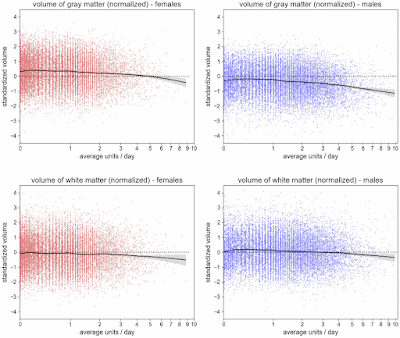In this cited publication, the authors note, by way of introduction:
Chronic alcohol use is associated with changes in brain structure and connectivity. Neuro–imaging studies have shown that chronic heavy alcohol consumption (3 or more drinks for women and 4 or more drinks for men on any day) is associated with widespread patterns of macro–structural and micro–structural changes.Our brains consist mostly of two types of cells: Grey matter and White matter. Grey matter contains most of the brain’s neuronal cell bodies — this includes those regions of the brain involved in muscle control, and sensory perception such as seeing and hearing, memory, emotions, speech, decision–making, and self–control. White matter is the tissue through which messages pass between different areas of Grey matter within the central nervous system. We need both types!
As a result of their work, the authors note:
Heavy alcohol consumption has been associated with brain atrophy, neuronal loss, and poorer White matter fiber integrity. However, there is conflicting evidence on whether light–to–moderate alcohol consumption shows similar negative associations with brain structure.By way of evidence, the authors produce the following multi–part graph (among others). It illustrates the relationships of the global Grey– and White–matter volumes with daily alcohol intake (on a log scale) for the different sexes. The figures include local polynomial regression lines (LOWESS), which indicate negative trends in each of the four cases. That is, increasing alcohol consumption leads to reduced brain matter for both males and females.
To address this, we examine the associations between alcohol intake and brain structure using multi–modal imaging data from 36,678 generally healthy middle–aged and older adults from the UK Biobank, a population sample whose reported alcohol consumption ranged from low (ie. 1–2 alcohol units per day) to high (ie. more than 4 alcohol units per day) levels of intake. [Note: a “unit of alcohol” is 10 ml of pure ethanol, so that 1 drink = 2 units.]
We find negative associations between alcohol intake and brain macro–structure and micro–structure. Specifically, alcohol intake is negatively associated with global brain volume measures, regional Gray matter volumes, and White matter micro–structure.
We show that the negative associations between alcohol intake and brain macro–structure and micro–structure are already apparent in individuals consuming an average of only one to two daily alcohol units, and become stronger as alcohol intake increases.
The authors conclude:
In summary, this study provides additional evidence for a negative association between alcohol intake and brain macro–structure and micro–structure in a general population sample of middle–aged and older adults. Alcohol intake is negatively associated with global brain volume measures, regional Gray matter volumes, and White matter micro–structure. Most of these negative associations are apparent in individuals consuming an average of only one to two daily alcohol units. Thus, this multi–modal imaging study highlights the potential for even moderate drinking to be associated with changes in brain volume in middle–aged and older adults.So, if you want to protect your brain, then you should be very careful about how much you drink. Indeed, regularly exceeding 2 drinks per day is clearly asking for long–term trouble, especially if you are no longer young.



Sadly, there are no age matched controls... this looks like normal aging volumes, but I'm only a published scientist with MD degree.
ReplyDeleteThere's a movement afoot (NA people? Religous??), claiming data and conclusions that fly in the face of the regular consumption of wine and beer in Mediterranean areas data that has been through the wash and wringer for decades. The nonsense coming out is sponsored by folks that want to tell you what to do... for example, alcohol raises HDL... inversely associated with MIs and death. Any first year med student can tell you how alcoholics have clean vasculature... please stop perpetuating the chicken little science!
The denial of established scientific facts, whether it's about the harmful effects of alcohol or the reality of climate change, is not just unhelpful, it's dangerous. It's time to move past outdated ideologies and face the facts. Our health and our planet depend on it.
Delete